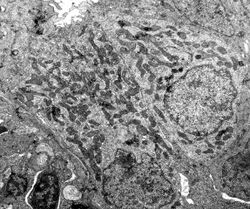Biology:Chloride cell
Chloride cells are cells in the gills of teleost fishes which pump excessive sodium and chloride ions out into the sea against a concentration gradient in marine fish. Alternatively, in the gills of freshwater teleost fish, they pump sodium and chloride ions into the fish, also against a concentration gradient.
Mechanism of action
Marine teleost fishes consume large quantities of seawater to reduce osmotic dehydration.[1] The excess of ions absorbed from seawater is pumped out of the teleost fishes via the chloride cells.[1] These cells use active transport on the basolateral (internal) surface to accumulate chloride, which then diffuses out of the apical (external) surface and into the surrounding environment.[2] Such mitochondria-rich cells are found in both the gill lamellae and filaments of teleost fish. Using a similar mechanism, freshwater teleost fish use these cells to take in salt from their dilute environment to prevent hyponatremia from water diffusing into the fish.[2]
References
- ↑ 1.0 1.1 Michael Allaby. "Chloride cells". A Dictionary of Zoology. http://www.encyclopedia.com/doc/1O8-chloridecells.html. Retrieved 4 July 2015.
- ↑ 2.0 2.1 Wilmer, Pat; Stone, Graham; Johnston, Ian (2005). Environmental Physiology of Animals. Malden, MA: Blackwell. pp. 85. ISBN 978-1-4051-0724-2. https://archive.org/details/environmentalphy00will/page/85.
External links
- "Chloride cells and osmoregulation", from Kidney International


